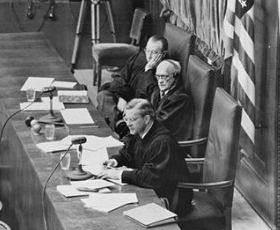Court Nuremberg | ||
 | ||
Full case name Trials of War Criminals before the Nuremberg Military Tribunals Indictment 9 December 1946, Nuremberg Decided 13 April 1949 (last case) | ||
The subsequent Nuremberg trials (formally the Trials of War Criminals before the Nuremberg Military Tribunals) were a series of twelve U.S. military tribunals for war crimes against members of the leadership of Nazi Germany, held in the Palace of Justice, Nuremberg, after World War II from 1946 to 1949 following the Trial of the Major War Criminals before the International Military Tribunal.
Contents
Background
Although it had been initially planned to hold more than just one international trial at the IMT, the growing differences between the victorious allies (the United States, United Kingdom, France, and Soviet Union) made this impossible. However, the Control Council Law No. 10, which the Allied Control Council had issued on 20 December 1945, empowered any of the occupying authorities to try suspected war criminals in their respective occupation zones. Based on this law, the U.S. authorities proceeded after the end of the initial Nuremberg Trial against the major war criminals to hold another twelve trials in Nuremberg. The judges in all these trials were American, and so were the prosecutors; the Chief of Counsel for the Prosecution was Brigadier General Telford Taylor. In the other occupation zones similar trials took place.
Trials
The twelve U.S. trials before the Nuremberg Military Tribunals (NMT) took place from 9 December 1946 to 13 April 1949. The trials were as follows:
Result
The Nuremberg process initiated 3,887 cases of which 3400 were dropped. Less than 500 cases (489) went to trial that involved 1672 defendants. 1416 were found guilty, but less than 200 were executed. Another 279 defendants were sent to life in prison but by the 1950s almost all of them have been released.
Many of the longer prison sentences were reduced substantially by decree of high commissioner John J. McCloy in 1951, and 10 outstanding death sentences from the Einsatzgruppen Trial were converted to prison terms. The same year, an amnesty released many of those who had received prison sentences.
Criticism
Some of the NMTs have been criticised for their conclusion that "moral bombing" of civilians, including its nuclear variety, was legal, and for their judgement that, in certain situations, executing civilians in reprisal was permissible.
Conduct of the prosecution
In a 2005 interview for the Washington Post, Benjamin B. Ferencz, Chief Prosecutor for the United States Army at the Einsatzgruppen Trial, revealed some of his activities during his period in Germany. "Someone who was not there could never really grasp how unreal the situation was," he said. The Americans delivered at least a dozen low-ranking German SS suspects to displaced persons camps for the purpose of having them executed by the DPs ("displaced persons"), without prior trial or sentencing. Under military law at that time, it was legal to hand over suspects to their victims for further questioning.
"I once saw DPs beat an SS man and then strap him to the steel gurney of a crematorium. They slid him in the oven, turned on the heat and took him back out. Beat him again, and put him back in until he was burnt alive. I did nothing to stop it. I suppose I could have brandished my weapon or shot in the air, but I was not inclined to do so. Does that make me an accomplice to murder?"In the interview, Ferencz also pointed out that the military legal norms at the time permitted actions that would not be possible today.
"You know how I got witness statements? I'd go into a village where, say, an American pilot had parachuted and been beaten to death and line everyone up against the wall. Then I'd say, 'Anyone who lies will be shot on the spot.' It never occurred to me that statements taken under duress would be invalid."